Improving Water Sustainability through Modeling Optimum Sites for Riparian Forest Reforestation
Abstract
1. Introduction
2. Materials and Methods
2.1. The Context of Using GIS, Fuzzy Logic, AHP and Sensitivity Analysis
2.2. Methodology Steps
2.3. Characterization
2.3.1. The Study Area
2.3.2. GIS Datasets
2.4. Selection of Drivers for the Success of Reforestation of Riparian Forests
- Bare soil, which is areas without vegetation, with reduced fertility and intense evaporation process, in addition to low humidity. They present exposure of mineral aggregates, laminar erosion by grooves and gullies. It is usually associated with the strong use of extensive livestock.
- Grass, which are areas of herbaceous or shrubby vegetation, being rich in grasses and legumes. They have relative humidity and soil fertility. However, there is a competition between species, hindering the regeneration process. They are generally used in livestock activities, burdening and endangering the reforestation process.
- Regeneration vegetation, which are areas in the FMP that present anthropic vegetation, develops from species growth that naturally regenerates in agricultural systems or after their abandonment. The humidity and fertility of riparian areas contribute to the development of this type of vegetation, with semi-dense characteristics and with the occurrence of laminar erosions [93,94]. The regeneration vegetation occurrence in areas to be reforested collaborates to increase the riparian forest.
2.5. Exclusion of Reforestation Unsuitable Areas
2.6. Prioritization of Areas for Reforestation
2.6.1. Criteria Selection and Categorization
2.6.2. Transformation of Criteria into Spatial Information
- Slope: Based on the Digital Elevation Model (DEM), ALOS, with 12.5 m of spatial resolution, from 2015, we used the Slope function to convert altitude information into the slope, and the Reclassify function to delimit the slope strips depending on their influence on the success of reforestation.
- Land use and cover map: The Sentinel 2, 2018 image, 10 m of the 16-bit radiometric resolution, was used to make this map. Using the Classification function, we identified the pixel information and, using the Training Sample Manager function, the pixels were grouped into classes, generating a spectral signature file. In this way, the Assisted Semi-Automatic Vectorization process was applied. We use the Classification function to classify the different elements of the image. In this way, the features that composed it were vectored, providing the following maps: vegetation, vulnerability of adjacent forest fragments to reforestation sites, distance from the forest fragment to the reforestation sites and constraint map.
- Vulnerability of adjacent forest fragments to reforestation sites: We used the Feature to Point tool to identify each fragment’s central point and the Join Data tool to attach each fragment’s measures to their respective central points. To determine the degree of vulnerability, we used buffers of 50 m and 150 m. Fragments in the 50 m buffer were considered highly vulnerable, those extrapolated in the 150 m buffer were considered low vulnerability and the remaining fragments were regarded as medium vulnerability.
- Distance from the forest fragment to the reforestation sites: We created distance classes from the central points of each fragment to classify the fragment according to the buffer in which its central point was inserted. We used buffers along the river with a distance of 0 to 150 m (Low), from 150 to 500 m (Average) and above 500 m (High).
- Vegetation: We used the Select by Attribute tool to extract the areas of forest, pasture and exposed soil from the land use and cover map.
- Constraints: We converted the vector data layers to the raster model to create a Boolean map. We assigned “pixel to pixel,” the index “1” for the areas considered suitable for reforestation, and “0” for the inadequate areas.
2.6.3. Establishment of Multi-Criteria Analysis and Fuzziness of the Judgment Procedures
2.6.4. Input Layers Aggregation
2.6.5. Evaluation of the Results’ Robustness
3. Results and Discussion
4. Conclusions
Author Contributions
Funding
Data Availability Statement
Acknowledgments
Conflicts of Interest
References
- Zhang, L.; Hickel, K.; Shao, Q. Predicting Afforestation Impacts on Monthly Streamflow Using the Dwbm Model. Ecohydrology 2017, 10, e1821. [Google Scholar] [CrossRef]
- Gashaw, T.; Tulu, T.; Argaw, M.; Worqlul, A.W. Modeling the Hydrological Impacts of Land Use/Land Cover Changes in the Andassa Watershed, Blue Nile Basin, Ethiopia. Sci. Total. Environ. 2018, 619, 1394–1408. [Google Scholar] [CrossRef] [PubMed]
- Dugdale, S.J.; Malcolm, I.A.; Kantola, K.; Hannah, D.M. Stream Temperature under Contrasting Riparian Forest Cover: Understanding Thermal Dynamics and Heat Ex-change Processes. Sci. Total. Environ. 2018, 610–611, 1375–1389. [Google Scholar] [CrossRef] [PubMed]
- Metzger, J.P. O Que é ecologia de Paisagens? Biota Neotrop. Camp. 2001, 1, 1–9. [Google Scholar] [CrossRef]
- Vital, A.R.T.; Guerrini, I.A.; Franken, W.K.; Fonesca, R.C.B. Produção de Serapilheira e Ciclagem de Nutrientes de uma Floresta Estacional Semidecidual em Zona Ripária. Rev. Árvore 2004, 28, 793–800. [Google Scholar] [CrossRef][Green Version]
- Lacerda, A.V.; Nordi, N.; Barbosa, F.M.; Watanabe, T. Levantamento Florístico Do Componente Arbustivo-Arbóreo Da Vegetação Ciliar NA Bacia Do Rio Taperoá, PB, Brasil. Acta Bot. Bras. 2005, 19, 647–656. [Google Scholar] [CrossRef]
- Attanasio, C.M.; Lima, W.P.; Gandolfi, S.; Zakia, J.M.B.; Veniziani, J.; Toledo, J.C. Método para a Adentificação da Zona Ripária: Microbacia Hidrográfica do Ribeirão São João (Mineiros do Tietê, SP). Sci. For. 2006, 71, 131–140. [Google Scholar]
- Chetkiewicz, C.-L.B.; Clair, C.C.S.; Boyce, M.S. Corridors for Conservation: Integrating Pattern and Process. Annu. Rev. Ecol. Evol. Syst. 2006, 37, 317–342. [Google Scholar] [CrossRef]
- Giehl, E.L.H.; Jarenkow, J.A. Gradiente Estrutural No Componente Arbóreo e Relação com Inundações em uma Floresta Ribeirinha, Rio Uruguai, Sul Do Brasil. Acta Bot. Bras. 2008, 22, 741–753. [Google Scholar] [CrossRef]
- Caissie, D. The Thermal Regime of Rivers: A Review. Freshw. Biol. 2006, 51, 1389–1406. [Google Scholar] [CrossRef]
- Marmontel, C.V.F.; Rodrigues, A.V. Indicative Parameters for Water Quality in Water Springs with Different Land Cover and Conservation of Riparian Vegetation. Floresta Ambiente 2015, 22, 171–181. [Google Scholar] [CrossRef]
- Tufekcioglu, A.; Raich, J.; Isenhart, T.; Schultz, R. Soil Respiration within Riparian Buffers and Adjacent Crop Fields. Plant Soil 2001, 229, 117–124. [Google Scholar] [CrossRef]
- Benyahya, L.; Caissie, D.; Satish, M.G.; El-Jabi, N. Long-Wave Radiation and Heat Flux Estimates within a Small Tributary in Catamaran Brook (New Brunswick, Canada). Hydrol. Process. 2012, 26, 475–484. [Google Scholar] [CrossRef]
- Dugdale, S.J.; Bergeron, N.E.; St-Hilaire, A. Spatial Distribution of Thermal Refuges Analysed in Relation to Riverscape Hydromorphology Using Airborne Thermal Infrared Imagery. Remote. Sens. Environ. 2015, 160, 43–55. [Google Scholar] [CrossRef]
- Garner, G.; Malcolm, I.A.; Sadler, J.P.; Hannah, D.M. What Causes Cooling Water Temperature Gradients in a Forested Stream Reach? Hydrol. Earth Syst. Sci. 2014, 18, 5361–5376. [Google Scholar] [CrossRef]
- Leach, J.A.; Moore, R.D. Above-Stream Microclimate and Stream Surface Energy Exchanges in a Wildfire-Disturbed Riparian Zone. Hydrol. Process. 2010, 24, 2369–2381. [Google Scholar] [CrossRef]
- Breau, C.; Cunjak, R.A.; Peake, S.J. Behaviour during Elevated Water Temperatures: Can Physiology Explain Movement of Juvenile Atlantic Salmon to Cool Water? J. Anim. Ecol. 2011, 80, 844–853. [Google Scholar] [CrossRef]
- Dugdale, S.J.; Franssen, J.; Corey, E.; Bergeron, N.E.; Lapointe, M.; Cunjak, R.A. Main Stem Movement of Atlantic Salmon Parr in Response to High River Temperature. Ecol. Freshw. Fish 2015, 25, 429–445. [Google Scholar] [CrossRef]
- Martins, E.G.; Hinch, S.G.; Patterson, A.D.; Hague, M.J.; Cooke, S.J.; Miller, K.M.; Robichaud, D.; English, K.K.; Farrell, A.P. High River Temperature Reduces Survival of Sockeye Salmon (Oncorhynchus Nerka) Approaching Spawning Grounds and Exacerbates Female Mortality. Can. J. Fish. Aquat. Sci. 2012, 69, 330–342. [Google Scholar] [CrossRef]
- Ilstedt, U.; Malmer, A.; Verbeeten, E.; Murdiyarso, D. The Effect of Afforestation on Water Infiltration in the Tropics: A Systematic Review and Meta-Analysis. For. Ecol. Manag. 2007, 251, 45–51. [Google Scholar] [CrossRef]
- Olaf, B.; Stefan, S.; Nico, E. Interactive Effects of Warming, Soil Humidity and Plant Diversity on Litter Decomposition and Microbial Activity. Soil Biol. Biochem. 2011, 43, 1902. [Google Scholar] [CrossRef]
- Godsey, S.; Elsenbeer, H. The Soil Hydrologic Response to Forest Regrowth: A Case Study from Southwestern Amazonia. Hydrol. Process. 2002, 16, 1519–1522. [Google Scholar] [CrossRef]
- Brauman, K.A.; Freyberg, D.L.; Daily, G.C. Potential Evapotranspiration from Forest and Pasture in the Tropics: A Case Study in Kona, Hawai’i. J. Hydrol. 2012, 440–441, 52–61. [Google Scholar] [CrossRef]
- Brummelhaus, J.; Weber, J.; Petry, M.V. The Influence of Riparian Forest Fragmentation on Birds in the River Hydro-Graphic Basin, Rio Grande do Sul State. Neotrop. Biol. Conserv. 2012, 7, 57–66. [Google Scholar]
- Kuntschik, D.P.; Eduarte, M.; Uehara, T. Matas Ciliares; Coordenadoria de Biodiversidade e Recursos Naturais Secretaria do Meio Ambiente: São Paulo, Brazil, 2014; Volume 2, pp. 80–86. [Google Scholar]
- Puth, L.; Wilson, K.A. Boundaries and Corridors: A Review of Streams and Their Role in the Landscape. Conserv. Biol. 2001, 15, 21–30. [Google Scholar] [CrossRef]
- Rodrigues, R.R.; Leitão Filho, H.F. Matas Ciliares, Conservação e Recuperação, 2nd ed.; Edusp: São Paulo, Brazil, 2001; p. 320. [Google Scholar]
- Carvalho, D.A.; Filho, A.O.; Vilela, E.A.; Curi, N.; Berg, E.V.D.; Fontes, M.; Botezelli, L. Distribuição de Espécies Arbóreo-Arbustivas ao Longo de um Gradiente de Solos e Topografia em um Trecho de Floresta Ripária Do Rio São Francisco em Três Marias, MG. Rev. Bras. Bot. 2005, 28, 2–345. [Google Scholar] [CrossRef]
- Dudgeon, D.; Angela, H.; Arthington, M.O.; Kawabata, G.Z.; Duncan, J.; Knowler, D.J.; Lévêque, C.; Naiman, R.J.; Prieur-Richard, A.; Soto, D.; et al. Freshwater Biodiversity: Importance, Threats, Status and Conservation Challenges. Biol. Rev. 2006, 81, 163–182. [Google Scholar] [CrossRef]
- Wantzen, K.M.; Mol, J.H. Soil Erosion from Agriculture and Mining: A Threat to Tropical Stream Ecosystems. Agriculture 2013, 3, 660–683. [Google Scholar] [CrossRef]
- Boulton, A.J.; Fenwick, G.D.; Hancock, P.J.; Harvey, M.S. Biodiversity, Functional Roles and Ecosystem Services of Groundwater Invertebrates. Invertebr. Syst. 2008, 22, 103–116. [Google Scholar] [CrossRef]
- Alexander, R.B.; Elizabeth, W.; Boyer Richard, A.; Smith, G.; Schwarz, R.E.; Moore, B. The Role of Headwater Streams in Downstream Water Quality. JAWRA 2007, 43, 41–59. [Google Scholar]
- Covich, A.P. Protecting Benthic Biodiversity to Insure Organic Matter Processing and Ecosystem Services: Importance of in-Vertebrate Shredders in Stream Networks. Ecotropicos 2006, 19, 109–127. [Google Scholar] [CrossRef]
- Lorion, C.M.; Kennedy, B.P. Relationships between Deforestation, Riparian Forest Buffers and Benthic Macroinvertebrates in Neotropical Headwater Streams. Freshw. Biol. 2008, 54, 165–180. [Google Scholar] [CrossRef]
- Villela, S.M.; Mattos, A. Hidrologia Aplicada; McGraw-Hill: São Paulo, Brazil, 1975; pp. 223–239. [Google Scholar]
- García-Ruiz, J.M.; Lana-Renault, N. Hydrological and Erosive Consequences of Farmland Abandonment in Europe, with Special Reference to the Mediterranean Region—A Review. Agric. Ecosyst. Environ. 2011, 140, 317–338. [Google Scholar] [CrossRef]
- Wiekenkamp, I.; Huisman, J.; Bogena, H.; Graf, A.; Lin, H.; Drüe, C.; Vereecken, H. Changes in Measured Spatiotemporal Patterns of Hydrological Response after Partial Deforestation in a Head-Water Catchment. J. Hydrol. 2016, 542, 648–661. [Google Scholar] [CrossRef]
- Armanini, A.; Righetti, M.; Grisenti, P. Direct Measurement of Vegetation Resistance in Prototype Scale. J. Hydraul. Res. 2005, 43, 481–487. [Google Scholar] [CrossRef]
- Li, J.-F.; Tfwala, S.; Chen, S.-C. Effects of Vegetation Density and Arrangement on Sediment Budget in a Sediment-Laden Flow. Water 2018, 10, 1412. [Google Scholar] [CrossRef]
- Wang, J.; Ning, S.; Khujanazarov, T. Modeling Hydrological Appraisal of Potential Land Cover Change and Vegeta-tion Dynamics under Environmental Changes in a Forest Basin. Forests 2018, 9, 451. [Google Scholar] [CrossRef]
- Bowmer, K.H. Ecosystem Effects from Nutrient and Pesticide Pollutants: Catchment Care as a Solution. Resources 2013, 2, 439–456. [Google Scholar] [CrossRef]
- Perkins, K.S.; Nimmo, J.R.; Medeiros, A.C.; Szutu, D.J.; von Allmen, E. Assessing Effects of Native Forest Restoration on Soil Moisture Dynamics and Potential Aquifer Recharge, Auwahi, Maui. Ecohydrology 2014, 54, 126–142. [Google Scholar] [CrossRef]
- Mrozińska, N.; Glińska-Lewczuk, K.; Burandt, P.; Kobus, S.; Gotkiewicz, W.; Szymańska, M.; Bąkowska, M.; Obolewski, K. Water Quality as an Indicator of Stream Restoration Effects—A Case Study of the Kwacza River Restoration Project. Water 2018, 10, 1249. [Google Scholar] [CrossRef]
- Braga, R.A.P. Avaliação dos instrumentos de Políticas Públicas na Conservação Integrada de Florestas e Águas, com Estudo de Caso na Bacia do Corumbataí—SP. Ph.D. Thesis, Escola de Engenharia de São Carlos, Universidade de São Paulo, São Carlos, Brazil, 2005. [Google Scholar]
- Ficke, A.D.; Myrick, C.A.; Hansen, L.J. Potential Impacts of Global Climate Change on Freshwater Fisheries. Rev. Fish Biol. Fish. 2007, 17, 581–613. [Google Scholar] [CrossRef]
- Morrill, J.C.; Bales, R.C.; Conklin, M.H. Estimating Stream Temperature from Air Temperature: Implications for Future Water Quality. J. Environ. Eng. 2005, 131, 139–146. [Google Scholar] [CrossRef]
- Van Vliet, M.T.; Franssen, W.H.; Yearsley, J.R.; Ludwig, F.; Haddeland, I.; Lettenmaier, D.P.; Kabat, P. Global River Discharge and Water Temperature under Climate Change. Glob. Environ. Chang. 2013, 23, 450–464. [Google Scholar] [CrossRef]
- Boyero, L.; Ramírez, A.; Dudgeon, D.; Pearson, R.G. Are Tropical Streams Really Different? J. N. Am. Benthol. Soc. 2009, 28, 397–403. [Google Scholar] [CrossRef]
- Güecker, B.; Boëchat, I.G.; Giani, A. Impacts of Agricultural Land Use on Ecosystem Structure and Whole-Stream Metabolism of Tropical Cerrado Streams. Freshw. Biol. 2009, 54, 2069–2085. [Google Scholar] [CrossRef]
- Silva Junior, C.H.L.; Aragão, L.E.O.C.; Fonseca, M.G.; Almeida, C.T.; Vedovato, L.B.; Anderson, L.O. Deforestation-Induced Fragmentation Increases Forest Fire Occurrence in Central Brazilian Amazonia. Forests. 2018, 9, 305. [Google Scholar] [CrossRef]
- Primack, R.B.; Rodrigues, E. Biologia da Conservação; Editora Planta: Londrina, Brazil, 2013; pp. 69–113. [Google Scholar]
- Gonzaga, L.A.P. Conservação e Atração das Aves; Fundação Brasileira para a Conservação da Natureza: Rio de Janeiro, Brazil, 1984; p. 54. [Google Scholar]
- Terborgh, J. Maintenance of Diversity in Tropical Forests. Biotropica 1992, 24, 283. [Google Scholar] [CrossRef]
- Goerck, J.M. Patterns of Rarity in the Birds of the Atlantic Forest of Brazil. Patrones de Rareza en las Aves del Bosque Atlantico de Brasil. Conserv. Biol. 1997, 11, 112–118. [Google Scholar] [CrossRef]
- Fontana, C.S.; Bencke, G.A.; Reis, R.E. Livro Vermelho da Fauna Ameaçada de Extinção no Rio Grande do Sul; EDIPUCRS: Porto Alegre, Brazil, 2003; p. 632. [Google Scholar]
- Gimenes, M.R.; Anjos, L. Efeitos da Fragmentação Florestal Sobre Comunidades de Aves. Acta Sci. Biol. Sci. 2003, 2, 391–402. [Google Scholar] [CrossRef]
- Laps, R.R.; Cordeiro, P.H.C.; Kajiwara, D.; Ribon, R.; Rodrigues, A.A.F.; Uejima, A. As Aves. In Fragmentação de Ecossistemas: Causas, Efeitos Sobre a Biodiversidade e Recomendações de Políticas Públicas; MMA/SBF: Brasília, Brazil, 2003; pp. 153–158. [Google Scholar]
- Chan, E.K.W.; Yu, Y.-T.; Zhang, Y.; Dudgeon, D. Distribution Patterns of Birds and Insect Prey in a Tropical Riparian Forest. Biotropica 2008, 40, 623–629. [Google Scholar] [CrossRef]
- Malczewski, J. GIS and Multicriteria Decision Analysis; John Wiley: New York, NY, USA, 1999; pp. 283–294. [Google Scholar]
- Chen, J. GIS-Based Multi-Criteria Analysis for Land use Suitability Assessment in City of Regina. Environ. Syst. Res. 2014, 3, 13. [Google Scholar] [CrossRef]
- Akbulak, C. Land use Suitability Analysis of the Upper Basin of the Kara Menderes River using Analytical Hierarchy Process and Geographicalinformation Systems. Int. J. Hum. Sci. 2010, 7, 557–576. [Google Scholar]
- Malczewski, J. GIS-Based Multicriteria Decision Analysis: A Survey of the Literature. Int. J. Geogr. Inf. Sci. 2006, 20, 703–726. [Google Scholar] [CrossRef]
- Phua, M.-H.; Minowa, M. A GIS-Based Multi-Criteria Decision Making Approach to Forest Conservation Planning at a Landscape Scale: A Case Study in the Kinabalu Area, Sabah, Malaysia. Landsc. Urban Plan. 2005, 71, 207–222. [Google Scholar] [CrossRef]
- Valente, R.O.A.; Vettorazzi, C.A. Comparação entre Métodos de Avaliação Multicriterial, em Ambiente SIG, para a Conservação e a Preservação Florestal. Sci. For. 2005, 69, 51–61. [Google Scholar]
- Jansssen, R.; Rietveld, P. Multicriteria Analysis and GIS: An Application to Agricultural Landuse in the Netherlands. In Geographical Lnformation Systems for Urban ’and Regional Planning; Kluwer: Dordrecht, The Netherlands, 1990; pp. 57–68. [Google Scholar]
- Kainz, W. Fuzzy Logic and GIS. Vienna: University of Vienna. Available online: http://homepage.univie.ac.at/wolfgang.kainz/Lehrveranstaltungen/ESRI_Fuzzy_Logic/File_2_Kainz_Text.pdf (accessed on 14 May 2020).
- Yanar, T.A.; Akyurek, Z. The Enhancement of the Cell-Based GIS Analysis with Fuzzy Processing Capabilities. Inf. Sci. 2006, 176, 1067–1085. [Google Scholar] [CrossRef]
- Robinson, V.B. A Perspective on the Fundamentals of Fuzzy Sets and Their Use in Geographic Information Systems. Trans. GIS 2003, 7, 3–30. [Google Scholar] [CrossRef]
- Saaty, T. The Analytic Hierarchy Process; McGraw-Hill: New York, NY, USA, 1980. [Google Scholar]
- Carver, S.J. Integrating Multi-Criteria Evaluation with Geographical Information Systems. Int. J. Geogr. Inf. Syst. 1991, 5, 321–339. [Google Scholar] [CrossRef]
- Malczewski, J. GIS-Based Land-Use Suitability Analysis: A Critical Overview. Prog. Plan. 2004, 62, 3–65. [Google Scholar] [CrossRef]
- Tang, Y.; Beynon, M.J. Application and Development of a Fuzzy Analytic Hierarchy Process within a Capital Investment Study. J. Econ. Manag. 2005, 1, 2, 207–230. [Google Scholar]
- Tsiko, R.G.; Haile, T.S. Integrating Geographical Information Systems, Fuzzy Logic and Analytical Hierarchy Process in Modelling Optimum Sites for Locating Water Reservoirs. A Case Study of the Debub District in Eritrea. Water 2011, 3, 254–290. [Google Scholar] [CrossRef]
- Arefiev, N.; Terleev, V.; Badenko, V. GIS-Based Fuzzy Method for Urban Planning. Procedia Eng. 2015, 117, 39–44. [Google Scholar] [CrossRef][Green Version]
- Lyu, H.-M.; Shen, S.-L.; Zhou, A.; Zhou, W.-H. Flood Risk Assessment of Metro Systems in a Subsiding Environment Using the Interval FAHP-FCA Approach. Sustain. Cities Soc. 2019, 50, 101682. [Google Scholar] [CrossRef]
- Kayastha, P.; Bijukchhen, S.M.; Dhital, M.R.; De Smedt, F. GIS Based Landslide Susceptibility Mapping Using a Fuzzy Logic Approach: A Case Study from Ghurmi-Dhad Khola Area, Eastern Nepal. J. Geol. Soc. India 2013, 82, 249–261. [Google Scholar] [CrossRef]
- Lin, W.-T.; Tsai, J.-S.; Lin, C.-Y.; Huang, P.-H. Assessing Reforestation Placement and Benefit for Erosion Control: A Case Study on the Chi-Jia-Wan Stream, Taiwan. Ecol. Model. 2008, 211, 444–452. [Google Scholar] [CrossRef]
- Niknejad, M.; Fallah, A.; Limaei, S.M. Sustainable Development of Reforestation Using Goal Programing and Fuzzy—AHP. Iran. J. For. Poplar Res. 2018, 26, 252–263. [Google Scholar] [CrossRef]
- Hassan, A.G.; Bakhtiar, F.; Thomas, B. GIS- Based Forest Fire Risk Mapping Using the Analytical Network Pro-cess and Fuzzy Logic. J. Environ. Plan. Manag. 2020, 63, 481–499. [Google Scholar] [CrossRef]
- Zadeh, L.A. Fussy Sets. Inform. Contr. 1965, 8, 338–353. [Google Scholar] [CrossRef]
- Mikhialov, L.; Tsvetinov, P. Evaluation of Services Using a Fuzzy Analytic Hierarchy Process. Appl. Soft. Comput. 2004, 5, 23–33. [Google Scholar] [CrossRef]
- Jiang, H.; Eastman, J.R. Application of Fuzzy Measures in Multi-Criteria Evaluation in GIS. Int. J. Geogr. Inf. Sci. 2000, 14, 173–184. [Google Scholar] [CrossRef]
- Chen, Y.; Yu, J.; Shahbaz, K.; Xevi, E. A GIS-Based Sensitivity Analysis of Multi-Criteria Weights. In Proceedings of the 18th World IMACS/MODSIM Congress, Cairns, Australia, 13–17 July 2009; pp. 13–17. [Google Scholar]
- SaltellI, A.; Tarantola, S.; Campolongo, F.; Ratto, M. Sensitivity Analysis in Practice: A Guide to Assessing Scientific Models, 1st ed.; John Wiley & Sons: West Sussex, UK, 2004. [Google Scholar]
- Xu, E.; Zhang, H. Spatially-Explicit Sensitivity Analysis for Land Suitability Evaluation. Appl. Geogr. 2013, 45, 1–9. [Google Scholar] [CrossRef]
- Köeppen, W. Climatologia: Con un Estudio de los Climas de la Tierra; Fondo de Cultura: Mexico City, Mexico, 1948; p. 474. [Google Scholar]
- Chambers, J.C. Seed Movements and Seedling Fates in Disturbed Sagebrush Steppe Ecosystems: Implications for Restoration. Col. Appl. 2000, 10, 1400–1413. [Google Scholar] [CrossRef]
- Rey, F.; Isselin-Nondedeu, F.; Bédécarrats, A. Vegetation Dynamics on Sediment Deposits Upstream of Bioengineering Works in Mountainous Marly Gullies in a Mediterranean Climate. Plant Soil. 2005, 278, 149–158. [Google Scholar] [CrossRef]
- Spurr, S.H.; Barnes, B.V. Forest Ecology, 2nd ed.; Ronald Press: New York, NY, USA, 1973; p. 575. [Google Scholar]
- Leão, S.R.F. Potencial Agrícola dos Solos do Distrito Federal. In Caracterização, Ocupação e Perspectivas; Pinto, M.N., Ed.; UnB: Brasília, Brazil, 1994; pp. 455–468. [Google Scholar]
- Jacomine, P.K.T. Solos Sob Matas Ciliares. In Matas Ciliares: Conservação e Recuperação, 2nd ed.; Universidade de São Paulo: São Paulo, Brazil, 2004; pp. 27–31. [Google Scholar]
- Correia, J.R.; Reatto, A.; Spera, S.T. Solos e Suas Relações com o Uso e o Manejo. Capítulo 1. In Cerrado Correção do Solo e Adubação; EMBRAPA Cerrados: Brasília, Brazil, 2004; pp. 29–62. Available online: http://www.bdpa.cnptia.embrapa.br/consulta/busca?b=ad&id=566223&biblioteca=CPAC&busca=autoria:%22REATTO,%20A.%22&qFacets=autoria:%22REATTO,%20A.%22&sort=&paginacao=t&paginaAtual=1 (accessed on 6 May 2020).
- Blaser, J.; Sabogal, C. Management Strategies for Degraded Landscapes. In Draft Guidelines for the Restoration of Degraded Primary Forests, the Management of Secondary Forests and the Rehabilitation of Degraded Forest Land in Tropical Regions; Draft report prepared on behalf of ITTO as basis for deliberations of the Expert Panel; ITTO: Bern, Switzerland, 2002. [Google Scholar]
- Vieira, I.; Proctor, J. Mechanisms of Plant Regeneration during Succession after Shifting Cultivation in Eastern Amazonia. Vegetable 2007, 192, 303–315. [Google Scholar] [CrossRef]
- Eriksson, O.; Ehrle’n, J. Seed and Microsite Limitation of Recruitment in Plant Population. Oecologia 1992, 91, 360–364. [Google Scholar] [CrossRef] [PubMed]
- Cerda, A.; Garcia-Fayos, P. The Influence of Seed Size and Shape on Their Removal by Water Erosion. Catena 2002, 48, 293–301. [Google Scholar] [CrossRef]
- Lachlan, S.C.; Dwyer, J.M.; Smith, T.J.; Connors, S.; Marschner, P.; Mayfield, M.M. Species wood density and the location of planted seedlings drive early-stage seedling survival during tropical forest restoration. J. Appl. Ecol. 2018, 55, 1009–1018. [Google Scholar] [CrossRef]
- Cheesman, A.W.; Preece, N.; Van Oosterzee, P.; Erskine, P.D.; Cernusak, L.A. The Role of Topography and Plant Functional Traits in Determining Tropical Reforestation Success. J. Appl. Ecol. 2018, 55, 1029–1039. [Google Scholar] [CrossRef]
- Hamilton, M.B. Tropical Tree Gene Flow and Seed Dispersal: Deforestation affects the Genetic Structure of the Surviving Forest Fragments. Nature 1999, 401, 129–130. [Google Scholar] [CrossRef]
- Tabarelli, M.; Peres, C.A. Abiotic and Vertebrate Seed Dispersal in the Brazilian Atlantic Forest: Implications for Forest Regenerations. Biol. Conserv. 2002, 106, 165–176. [Google Scholar] [CrossRef]
- Turner, I.M.; Corlett, R.T. The Conservation Value of Small, Isolated Fragments of Lowland Tropical Rain Forest. Trends. Ecol. Evol. 1996, 11, 330–333. [Google Scholar] [CrossRef]
- Pither, R.; Kellman, M. Tree Species Diversity in Small, Tropical Riparian Forest Fragments in Belize, Central America. Biodivers. Conserv. 2002, 11, 1623–1636. [Google Scholar] [CrossRef]
- Machado, F.S.; Fontes, M.A.L.; dos Santos, R.M.; Garcia, P.O.; Farrapo, C.L. Tree Diversity of Small Forest Fragments in Ecotonal Regions: Why Must These Fragments Be Preserved? Biodivers. Conserv. 2016, 25, 525–537. [Google Scholar] [CrossRef]
- Fahrig, L. Effects of Habitat Fragmentation on Biodiversity. Annu. Rev. Ecol. Evol. Syst. 2003, 34, 487–515. [Google Scholar] [CrossRef]
- Gómez-Aparicio, L.; Patrick, H.M.; Charles, D.C. Neighbourhood Models of the Ffects of the Invasive Acer Platanoides on Tree Seedling Dynamics: Linking Impacts on Communities and Ecosystems. J. Ecol. 2008, 96, 78–90. [Google Scholar] [CrossRef]
- Ragusa-Netto, J.; Santos, A.A. Seed Rain Generated by Bats under Cerrado’s Pasture Remnant Trees in a Neotropical Savanna. Braz. J. Biol. 2015, 75, 25–34. [Google Scholar] [CrossRef]
- Hobbs, R.J.; Norton, D.A. Towards a Conceptual Framework for Restoration Ecology. Restor. Ecol. 1996, 4, 93–110. [Google Scholar] [CrossRef]
- Parrotta, J.A.; John, W.; Turnbull, N.J. Catalyzing Native Forest Regeneration on Degraded Tropical Lands. For. Ecol. Manag. 1997, 99, 1–7. [Google Scholar] [CrossRef]
- Holl, K.D.; Michael, E.L.; Eleanor, H.V.L.; Ivan, A.S. Tropical Montane Forest Restoration in Costa Rica: Overcoming Barriers to Dispersal and Establishment. Restotaition Ecol. 2000, 8, 339–349. [Google Scholar] [CrossRef]
- Sansevero, J.B.B.; Prieto, P.; de Moraes, V.; Rodrigues, L.F.D. Natural Regeneration in Plantations of Native Trees in Lowland Brazilian Atlantic Forest: Community Structure, Diversity, and Dispersal Syndromes. Restor. Ecol. 2011, 19, 379–389. [Google Scholar] [CrossRef]
- Johst, K.; Brandl, R.; Eber, S. Metapopulation Persistence in Dynamic Landscapes: The Role of Dispersal Distance. Oikos 2002, 98, 263–270. [Google Scholar] [CrossRef]
- Howe, H.F.; Miriti, M.N. When Seed Dispersal Matters. Bio. Sci. 2004, 54, 651–660. [Google Scholar] [CrossRef]
- Higgins, S.I.; Lavorel, S.; Revilla, E. Estimating Plant Migration Rates under Habitat Loss and Fragmentation. Oikos 2003, 101, 354–366. [Google Scholar] [CrossRef]
- Pearson, R.G.; Dawson, T.P. Long-Distance Plant Dispersal and Habitat Fragmentation: Identifying Conservation Targets for Spatial Land-Scape Planning under Climate Change. Biol. Conserv. 2005, 123, 389–401. [Google Scholar] [CrossRef]
- Juvanhol, R.S. Análise Espacial De Fragmentos Florestais No Corredor Ecológico Entre Os Parques Estaduais De Forno Grande e Pedra Azul, ES; Universidade Federal do Espirito Santo—UFES: Espirito Santo, Brazil, 2011. [Google Scholar] [CrossRef]
- Cavalcante, D.G.; Pinheiro, E.S.; de Macedo, M.A.; Martinot, J.F.; Nascimento, A.A.Z.; Marques, J.P.C. Análise da Vulnerabilidade Ambiental de um Fragmento Florestal Urbano na Amazônia: Parque Estadual Sumaúma. Soc. Nat. 2010, 22, 391–403. [Google Scholar] [CrossRef]
- Saunders, D.A.; Hobbs, R.J.; Margules, C.R. Biological Consequence of Ecosystem Fragmentation: A Review. Conserv. Biol. 1991, 5, 18–32. [Google Scholar] [CrossRef]
- Tabanez, A.A.J.; Viana, V.M. Patch Structure within Brazilian Atlantic Forest Fragments and Implications for Conservation. Biotropica 2000, 32, 925–933. [Google Scholar] [CrossRef]
- Ribeiro, J.F. (Ed.) Cerrado: Matas de Galeria; Embrapa: Planaltina, Brazil, 1998; pp. 1–16. [Google Scholar]
- Portela, R.C.Q.; Santos, F.A.M. Litter Production and Accumulation in the Edge and Interior of Atlantic Rain Forest Fragments of Different Sizes. Rev. Bras. Bot. 2007, 30, 271–280. [Google Scholar] [CrossRef][Green Version]
- Lima, A.R.; Capobianco, J.P.R. Mata Atlântica: Avanços Legais e Institucionais para Sua Conservação; Documentos ISA, Instituto Socioambiental: São Paulo, Brazil, 1997. [Google Scholar]
- Gomes, E.P.C.; Simey, T.V.F.; Waldir, M. Estrutura e Composição do Componente Arbóreo na Reserva Ecológica do Trabiju, Pindamonhangaba, SP, Brazil. Acta Bot. Bras. 2005, 19, 451–464. [Google Scholar] [CrossRef]
- Liddle, M. Recreation Ecology: The Ecological Impact of Outdoor Recreation and Ecotourism; Chapman & Hall: London, UK, 1997. [Google Scholar]
- Whittington, J.; Clair, C.C.S.; Mercer, G. Spatial Responses of Wolves to Roads and Trails in Mountain Valleys. Ecol. Appl. 2005, 15, 543–553. [Google Scholar] [CrossRef]
- Brasil. Lei n° 12.651, de 25 de maio de 2012. Dispõe Sobre a Proteção da Vegetação Nativa e dá Outras Providências. Presidência da República. Casa Civil. 2012. Available online: http://www.planalto.gov.br/ccivil_03/_ato2011-2014/2012/lei/l12651.htm (accessed on 14 June 2020).
- Cole, R.J.; Holl, K.D.; Keene, C.L.; Zahawi, R.A. Direct Seeding of Late-Successional Trees to Restore Tropical Montane Forest. For. Ecol. Manag. 2011, 261, 1590–1597. [Google Scholar] [CrossRef]
- La Peña-Domene, M.; Martínez-Garza, C.; Ayestarán-Hernández, L.M.; Howe, H.F. Plant Attributes that Drive Dispersal and Establishment Limitation in Tropical Agricultural Landscapes. Forests 2018, 9, 620. [Google Scholar] [CrossRef]
- Dos Santos, M.J.C.; Nascimento, A.V.S.; Silva, C.E. Caracterização Dos Remanescentes Florestais Naturais da Zona Rural de Guapiara. Nat. Resour. 2011, 1, 23–36. [Google Scholar] [CrossRef]
- Brasil, Empresa Brasileira de Pesquisa Agropecuária. Mapa de Solo/Minas Gerais. 1970. Available online: https://www.embrapa.br/mapa-da-embrapa-no-brasil (accessed on 5 July 2019).
- Eastman, J.R. IDRISI Kilimanjaro: Guide to GIS and Image Processing; Clarke Labs, Clarke University: Worcester, MA, USA, 2003; p. 300. [Google Scholar]
- Saaty, T.L. Theory and Applications of the Analytic Network Process: Decision Making with Benefits, Opportunities, Costs, and Risks; RWS Publications: Pittsburgh, PA, USA, 2005; p. 352. [Google Scholar]
- Kwiesielewicz, M. A Note on the Fuzzy Extension of Saaty’s Priority Theory. Fuzzy Sets Syst. 1998, 95, 161–172. [Google Scholar] [CrossRef]
- Chang, D.-Y. Applications of the Extent Analysis Method on Fuzzy AHP. Eur. J. Oper. Res. 1996, 95, 649–655. [Google Scholar] [CrossRef]
- Van Laarhoven, P.J.M.; Pedrycz, W. A Fuzzy Extension of Saaty’s Priority Theory. Fuzzy Sets Syst. 1983, 11, 229–241. [Google Scholar] [CrossRef]
- Gogus, O.; Boucher, T.O. Strong Transitivity, Rationality and Weak Monotonicity in Fuzzy Pairwise Comparisons. Fuzzy Sets Syst. 1998, 94, 133–144. [Google Scholar] [CrossRef]
- Vivas Neto, D.C. Corredores Dendríticos em Paisagem Alterada: Uma Proposta Metodológica. 2006. Available online: http://www.dominiopublico.gov.br/pesquisa/DetalheObraForm.do?select_action=&co_obra=61960 (accessed on 9 January 2020).
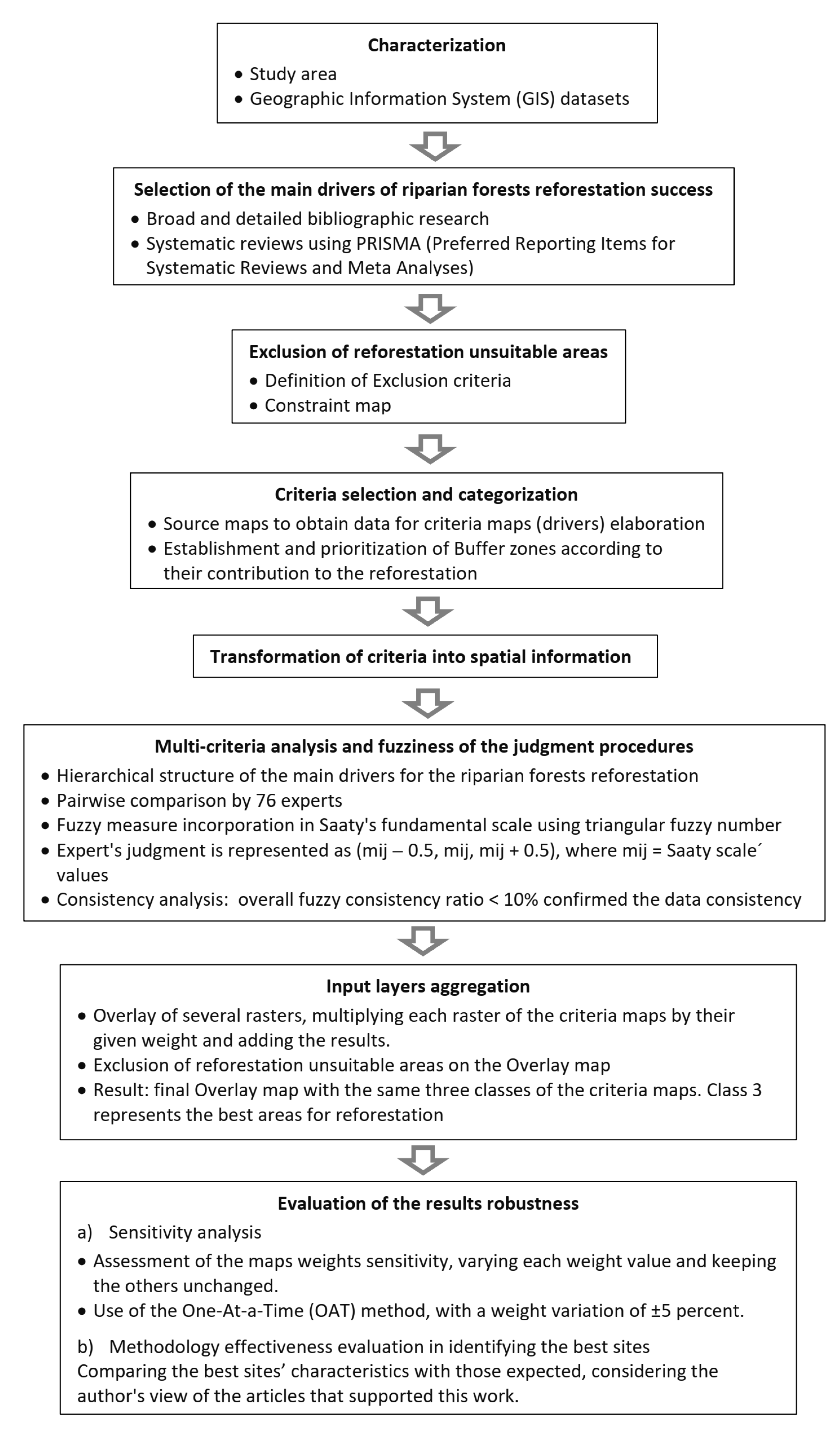
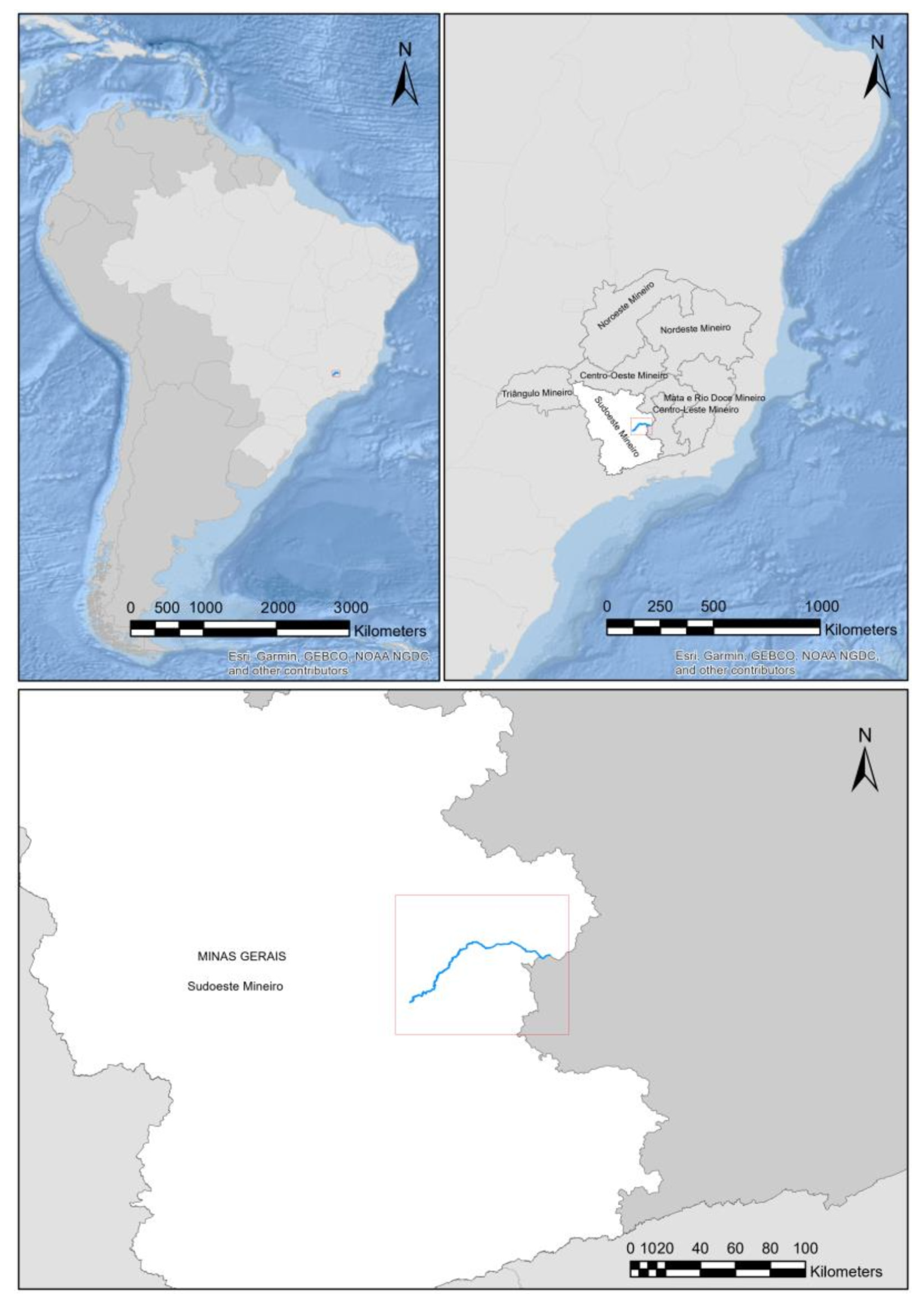
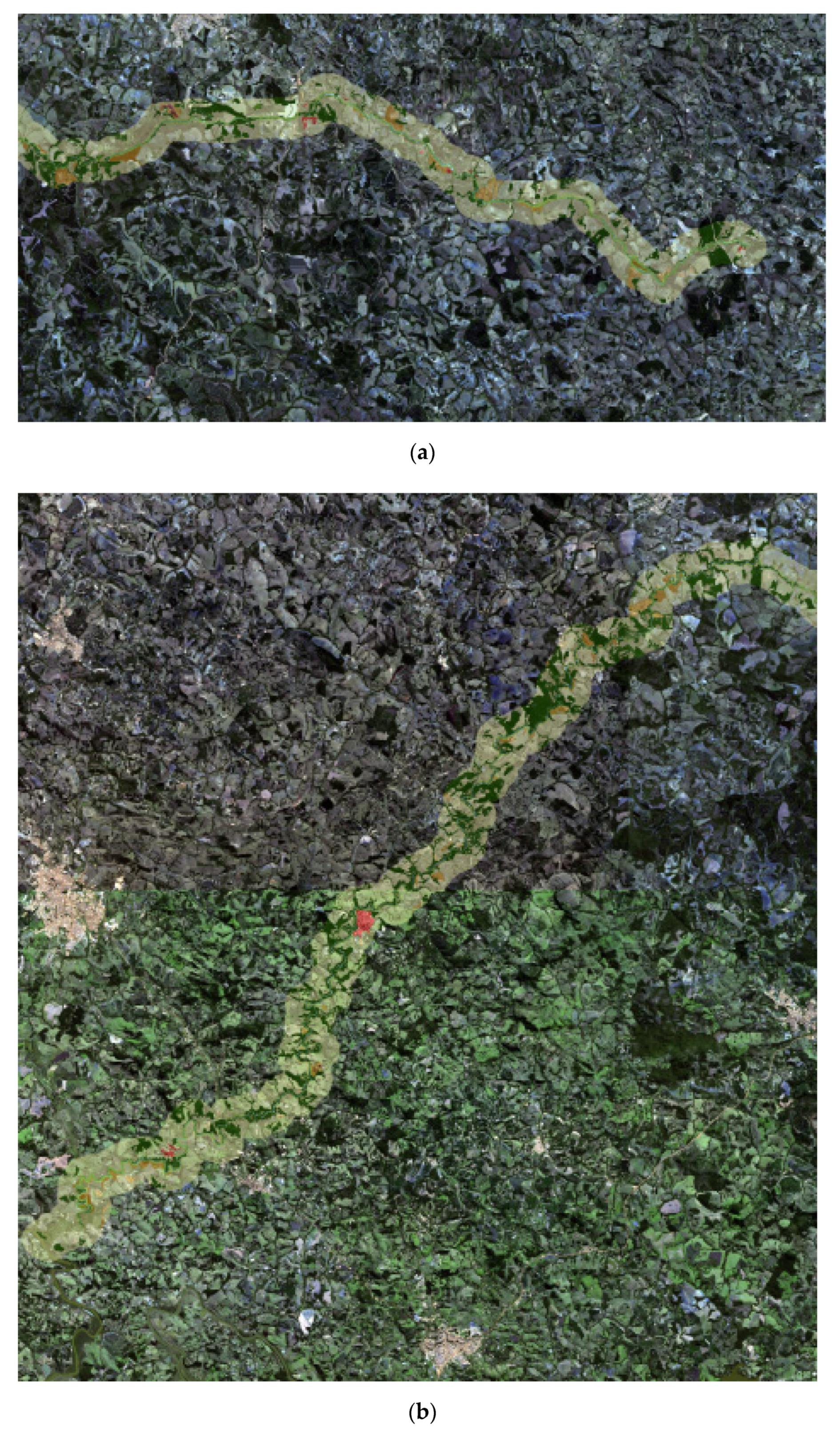
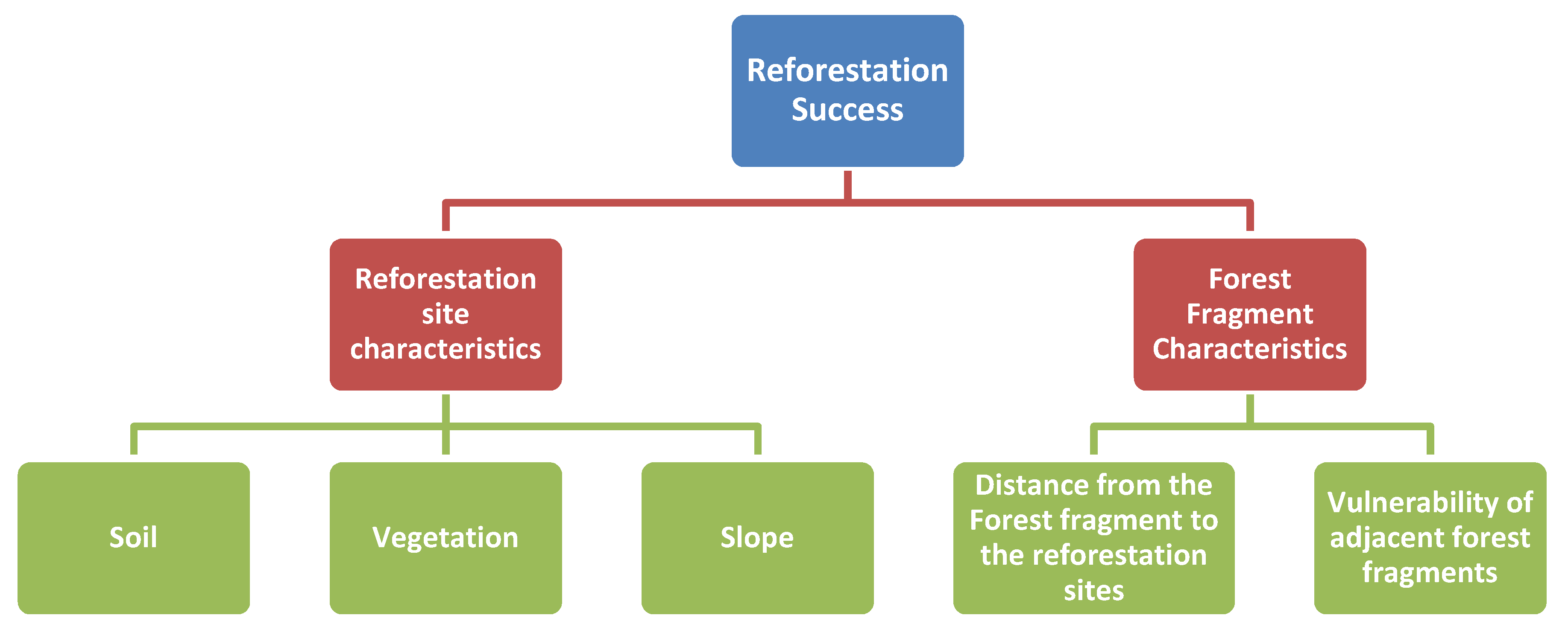
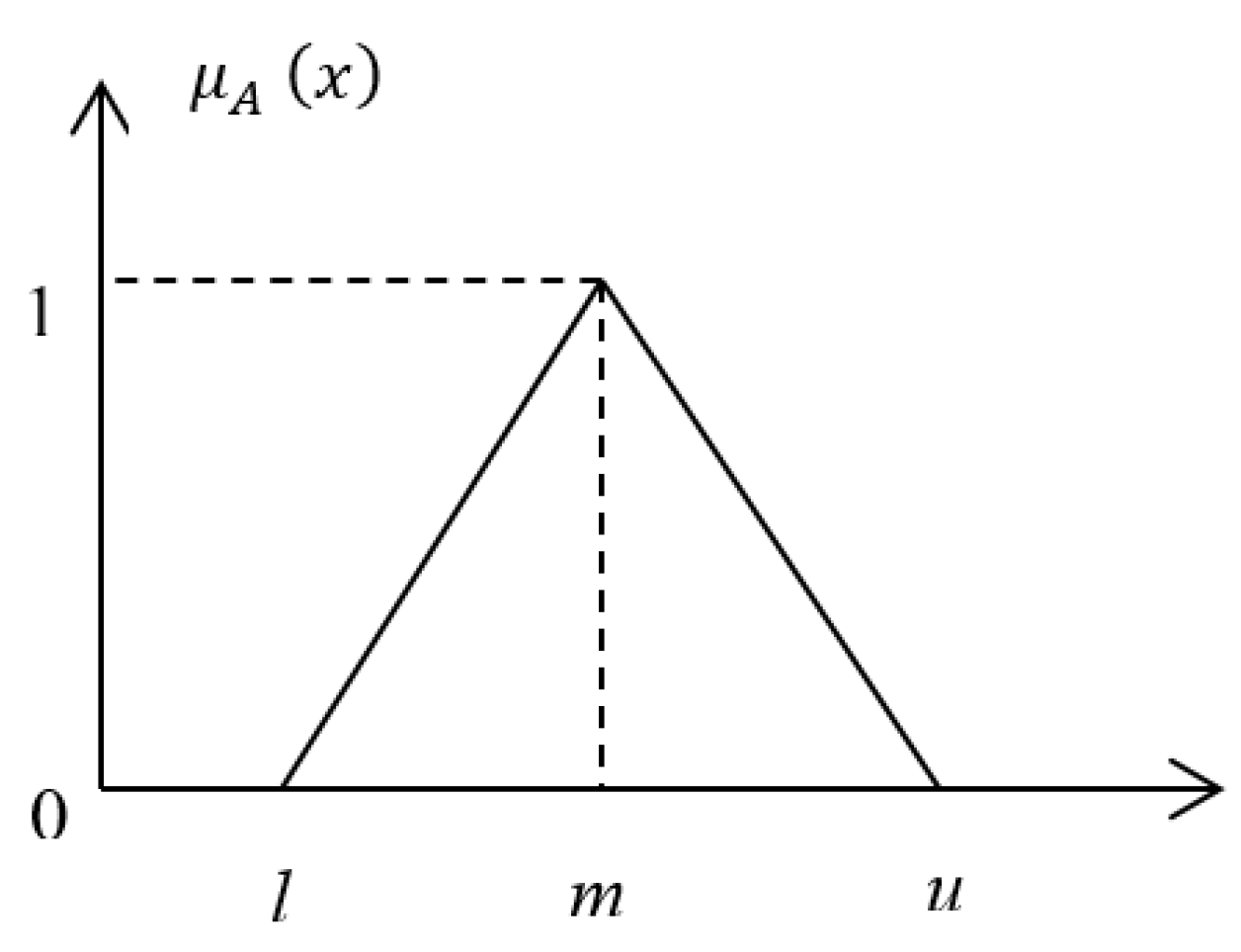

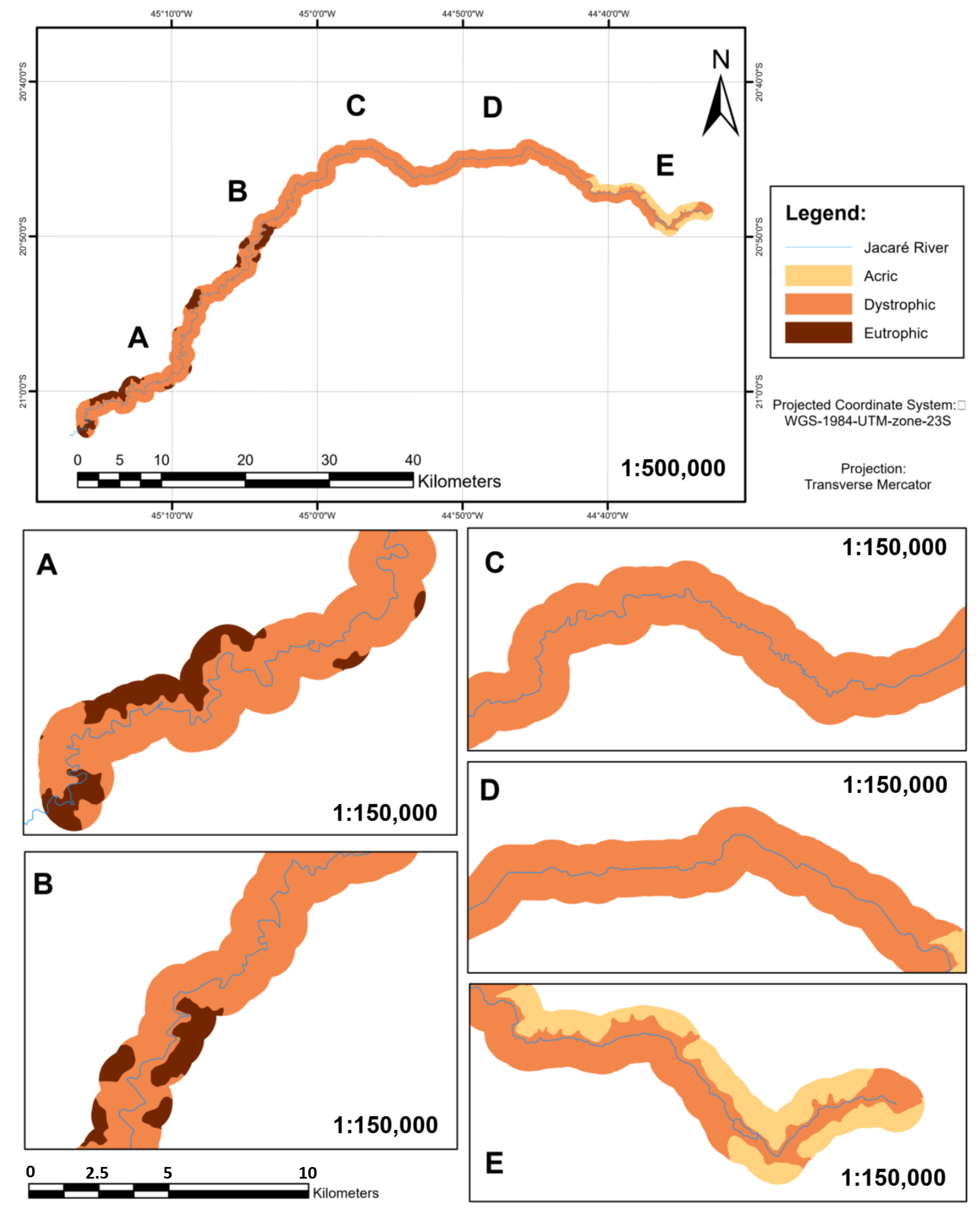


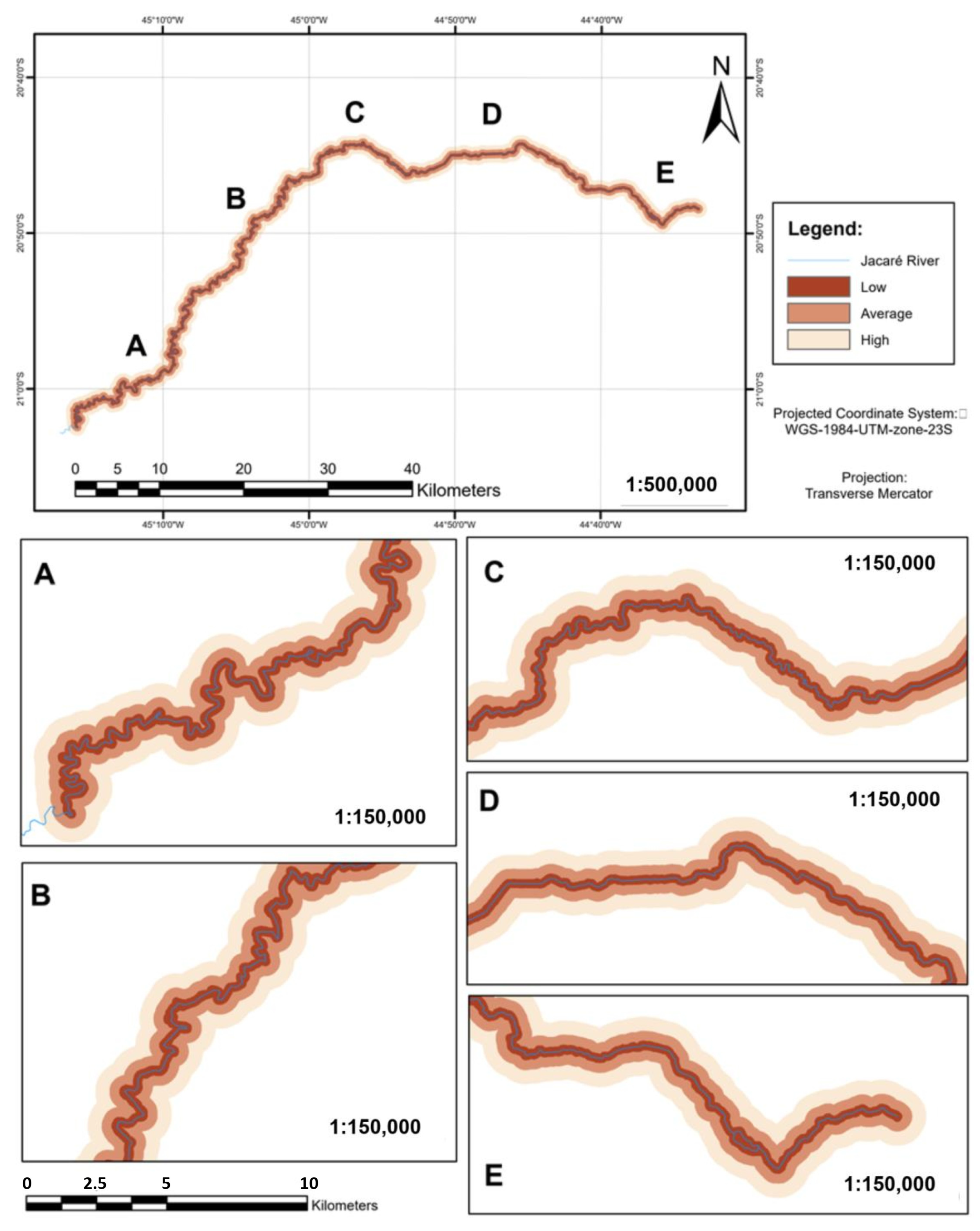
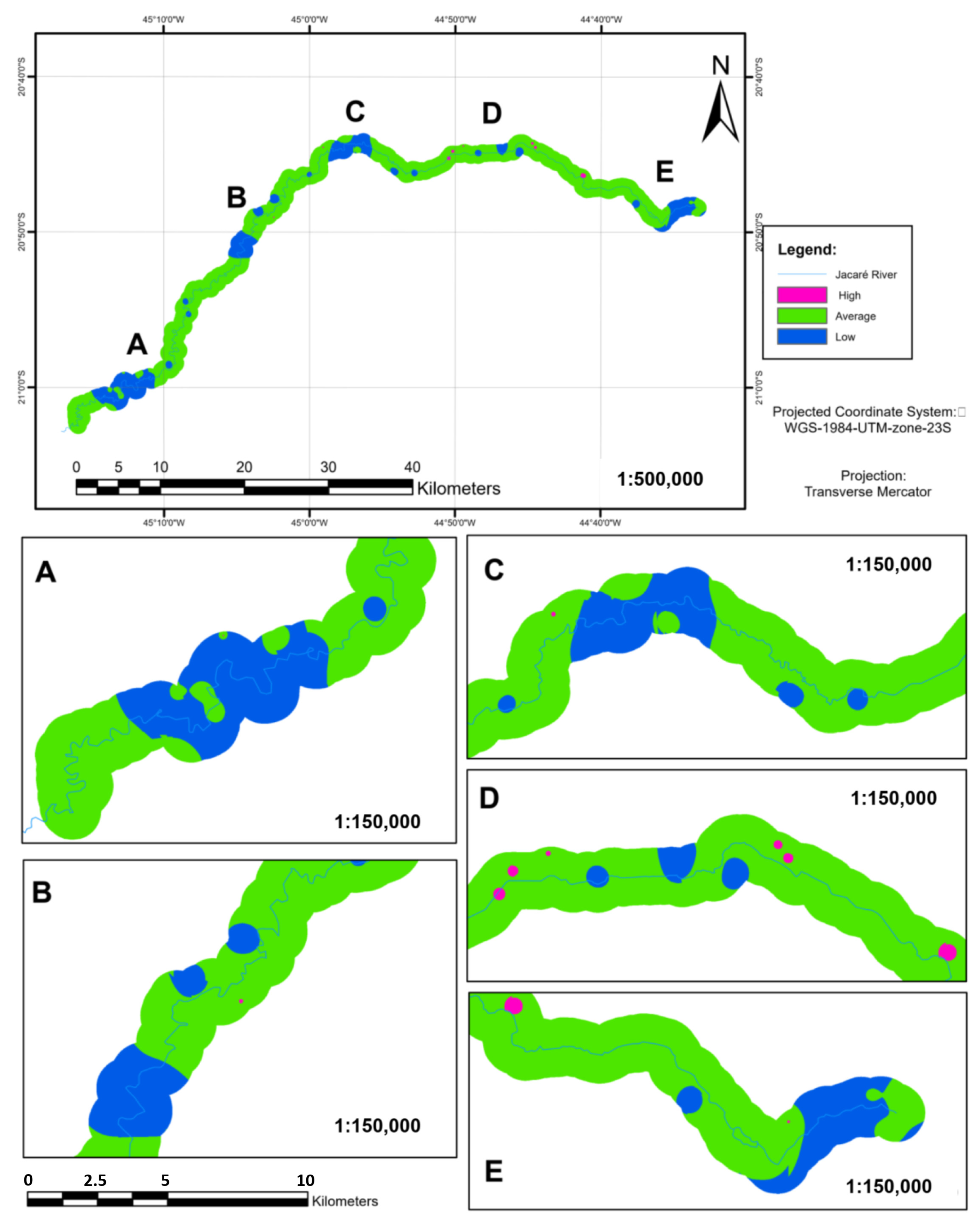
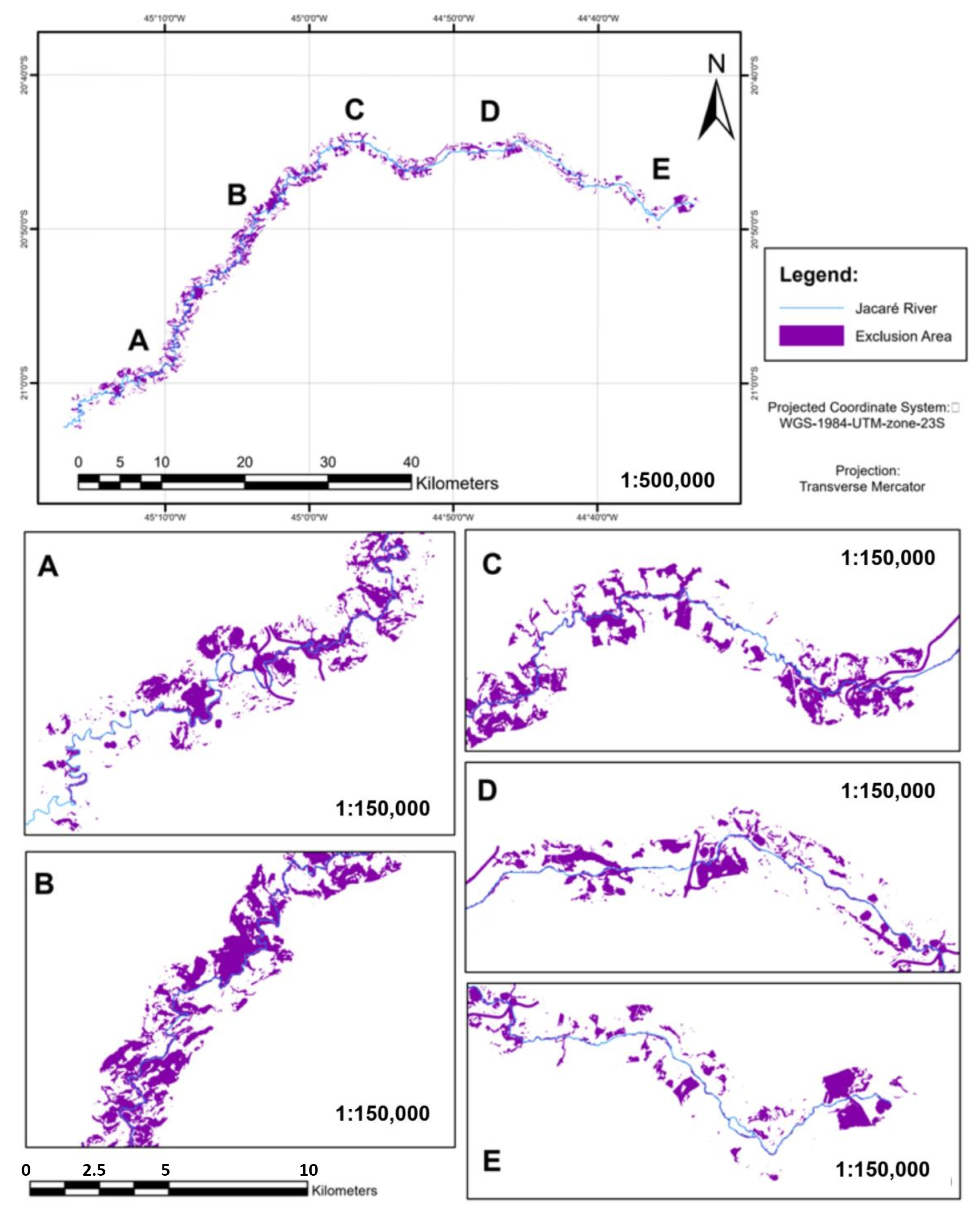

| Action | Occurrence | Procedure |
|---|---|---|
| Selection of the main factors of riparian forests’ reforestation success | Some important factors are not being identified | Broad and detailed bibliographic research using a widely used systematic reviews method: PRISMA (Preferred Reporting Items for Systematic Reviews and Meta Analyses) |
| Establishment of weights for the factors according to the relative importance between them |
|
|
| Input layers aggregation | Variations in the weights can influence the assessment of which areas are part of a particular class of importance. | Use of the One-At-a-Time (OAT) method to perform sensitivity analysis based on the variation of the weights in a predefined interval |
| Methodology effectiveness evaluation in identifying the best sites | Best sites’ characteristics to be incompatible with the literature on the topic | Comparing the best sites’ characteristics with those expected, considering the authors’ view of the articles that supported this work |
| Layer Name | Source Map | Buffer Zone | Classes |
|---|---|---|---|
| Slope | ALOS PALSAR DTM image with 12.5 m resolution. | ≤15% | 3 |
| >15% ≤ 30% | 2 | ||
| >30% ≤ 100% | 1 | ||
| Soil | EMBRAPA Geological Map 1:30,000 | Eutrophic | 3 |
| Dystrophic | 2 | ||
| Acric | 1 | ||
| Vegetation | Satellite image: Sentinel-2 with 10m spatial resolution. | Regeneration Vegetation | 3 |
| Grass | 2 | ||
| Bare soil | 1 | ||
| Vulnerability of adjacent forest fragments | Satellite image: Sentinel-2 with 10 m spatial resolution. | Fragments that go beyond the 100 m buffer | 3 |
| The other fragments | 2 | ||
| Fragments in the 50 m buffer | 1 | ||
| Distance from the forest fragment to the reforestation sites | Satellite image: Sentinel-2 with 10 m spatial resolution | Low (0 to 150 m) | 3 |
| Average (150 to 500 m) | 2 | ||
| High (500 to 1000 m) | 1 |
| Numerical Scale | Verbal Scale |
|---|---|
| 1 | Equal importance |
| 3 | Moderate importance |
| 5 | Strong importance |
| 7 | Very Strong importance |
| 9 | Extreme importance |
| 2, 4, 6, 8 | Intermediate values |
| Reciprocals of above non-zero numbers | If an activity has one of the above numbers (e.g., 5) compared with a second activity, then the second activity has the reciprocal value when compared to the first (i.e., 1/5). |
| Saaty’s Scale | Verbal Scale | Membership Function | (l, m, u) |
|---|---|---|---|
| Just equal | (1.0, 1.0, 1.0) | ||
| 1 | Equal importance | μA(x) = (2 − x)/(2 − 1) for 1 ≤ x ≤ 2 | (1.0, 1.0, 1,5) |
| 2 | Equal to Moderate | μA(x) = (x − 1)/(2 − 1) for 1 ≤ x ≤ 2 μA(x) = (3 − x)/(3 − 2) for 2 ≤ x ≤ 3 | (1.5, 2.0, 2.5) |
| 3 | Moderate importance | μA(x) = (x −2)/(3 − 2) for 2 ≤ x ≤ 3 μA(x) = (4 − x)/(4 − 3) for 3 ≤ x ≤ 4 | (2.5, 3.0, 3.5) |
| 4 | Moderate to Strong | μA(x) = (x − 3)/(4 − 3) for 3 ≤ x ≤ 4 μA(x) = (5 − x)/(5 − 4) for 4 ≤ x ≤ 5 | (3.5, 4.0, 4.5) |
| 5 | Strong importance | μA(x) = (x − 4)/(5 − 4) for 4 ≤ x ≤ 5 μA(x) = (6 − x)/(6 − 5) for 5 ≤ x ≤ 6 | (4.5, 5.0, 5.5) |
| 6 | Strong to Very Strong | μA(x) = (x − 5)/(6 − 5) for 5 ≤ x ≤ 6 μA(x) = (7 − x)/(7 − 6) for 6 ≤ x ≤ 7 | (5.5, 6.0, 6.5) |
| 7 | Very Strong importance | μA(x) = (x − 6)/(7 − 6) for 6 ≤ x ≤ 7 μA(x) = (8 − x)/(8 − 7) for 7 ≤ x ≤ 8 | (6.5, 7.0, 7.5) |
| 8 | Very Strong to Extreme | μA(x) = (x − 7)/(8 − 7) for 7 ≤ x ≤ 8 μA(x) = (9 − x)/(9 − 8) for 8 ≤ x ≤ 9 | (7.5, 8.0, 8.5) |
| 9 | Extreme importance | μA(x) = (x − 8)/(9 − 8) for 8 ≤ x ≤ 9 | (8.5, 9.0, 9.0) |
| Reciprocals of the above numbers | A1−1 ≈ (1/uij,1/mij,1/lij) | ||
| n | 1 | 2 | 3 | 4 | 5 | 6 | 7 | 8 | 9 | 10 | 11 | 12 | 13 | 14 | 15 |
|---|---|---|---|---|---|---|---|---|---|---|---|---|---|---|---|
| Rim | 0 | 0 | 0.489 | 0.794 | 1.072 | 1.200 | 1.287 | 1.341 | 1.379 | 1.410 | 1.418 | 1.446 | 1.456 | 1.491 | 1.499 |
| RIq | 1 | 2 | 0.180 | 0.263 | 0.360 | 0.382 | 0.409 | 0.416 | 0.435 | 0.446 | 0.454 | 0.478 | 0.469 | 0.480 | 0.488 |
| Layer Name | Weight Variation | Number of Classes | ||
|---|---|---|---|---|
| 1 | 2 | 3 | ||
| Number of Overlay Classes | 1 | 117 | 60 | |
| Slope | +5% | 1 | 118 | 61 |
| −5% | 1 | 118 | 60 | |
| Soil | +5% | 1 | 118 | 61 |
| −5% | 1 | 118 | 60 | |
| Vegetation | +5% | 1 | 118 | 60 |
| −5% | 1 | 118 | 60 | |
| Vulnerability of adjacent forest fragments to the reforestation sites | +5% | 1 | 118 | 65 |
| −5% | 1 | 120 | 61 | |
| Distance from the forest fragment to the reforestation sites | +5% | 1 | 118 | 60 |
| −5% | 1 | 118 | 61 | |
Publisher’s Note: MDPI stays neutral with regard to jurisdictional claims in published maps and institutional affiliations. |
© 2020 by the authors. Licensee MDPI, Basel, Switzerland. This article is an open access article distributed under the terms and conditions of the Creative Commons Attribution (CC BY) license (http://creativecommons.org/licenses/by/4.0/).
Share and Cite
Torres, D.H.A.; Vivas Neto, D.d.C.; Santos, D.V.M.d.; Soares, C.A.P. Improving Water Sustainability through Modeling Optimum Sites for Riparian Forest Reforestation. Water 2021, 13, 46. https://doi.org/10.3390/w13010046
Torres DHA, Vivas Neto DdC, Santos DVMd, Soares CAP. Improving Water Sustainability through Modeling Optimum Sites for Riparian Forest Reforestation. Water. 2021; 13(1):46. https://doi.org/10.3390/w13010046
Chicago/Turabian StyleTorres, Daniel Henrique Alves, Dácio de Castro Vivas Neto, Danilo Vieira Mendes dos Santos, and Carlos Alberto Pereira Soares. 2021. "Improving Water Sustainability through Modeling Optimum Sites for Riparian Forest Reforestation" Water 13, no. 1: 46. https://doi.org/10.3390/w13010046
APA StyleTorres, D. H. A., Vivas Neto, D. d. C., Santos, D. V. M. d., & Soares, C. A. P. (2021). Improving Water Sustainability through Modeling Optimum Sites for Riparian Forest Reforestation. Water, 13(1), 46. https://doi.org/10.3390/w13010046






